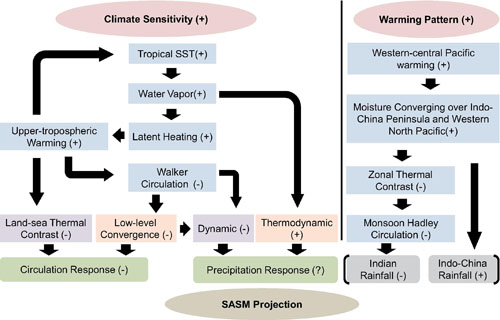Why Are Large Uncertainties Observed in the Projected South Asian Summer Monsoon by Climate Models?
Date:2015-11-03
Climate projection under various green-house gas (GHG) emission scenarios representing specific socioeconomic developments is the scientific basis for mitigation and adaption to climate change. However, the projected climate changes in the future by numerous models under the same scenario vary dramatically one another, especially in a regional scale like monsoon system. So what causes such uncertainties in the model projections?
To answer this question, Dr. CHEN Xiaolong and Prof. ZHOU Tianjun from Institute of Atmospheric Physics, Chinese Academy of Sciences, investigated the projected uncertainty in the South Asian summer monsoon (SASM) under the RCP8.5 scenario using 35 state-of-the-art models from the Fifth Phase of the Coupled Model Intercomparison Project. The results show that the large-scale monsoon circulations are controlled by the global mean warming magnitude, reflecting the influence of diverse climate sensitivity on the projections among models. Weaker monsoon circulation is projected by models highly sensitive to GHG concentration. In contrast, intermodal discrepancy of projected precipitation is independent of the global mean warming, due to the compensation between the weakened circulation and increased water vapor across models.
"In fact, the uncertainty in the projected monsoon rainfall is controlled by the sea surface temperature warming magnitude of the western-central Pacific.” Explains Prof. ZHOU. They found the western-central Pacific warming can impact the monsoon rainfall by modulating zonal temperature gradient over the monsoon domain (Fig. 1). And the weak relation between the intermodal global mean warming and monsoon rainfall limits the application of “Pattern Scaling” method in impact assessment on the regional hydrological cycle change imposed by green-house gas forcing.

Fig. 1. Flow diagrams showing how projected SASM under GHG forcing changes with the climate sensitivity and warming pattern. The “+" sign denotes that a term is increasing or enhanced; “-" sign denotes that a term is decreasing or weakened; and “?" denotes that a term is uncertain. (Chen and Zhou, 2015)
This study reveals the different mechanisms causing the uncertainties in the large-scale monsoon circulation and precipitation. The study also emphasizes the important role of sea surface warming pattern in the projected regional climate changes, especially the hydrological change, which provides the fundamental to reduce the uncertainty in the SASM projections.
For details, please refer to the following paper:
Chen, Xiaolong, Tianjun Zhou*, 2015: Distinct effects of global mean warming and regional sea surface warming pattern on projected uncertainty in the South Asian summer monsoon. Geophysical Research Letters, DOI: 10.1002/2015GL066384.
Contact: ZHOU Tianjun, zhoutj@lasg.iap.ac.cn
